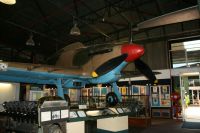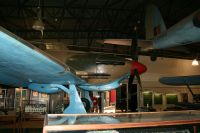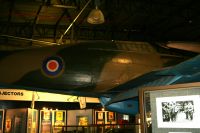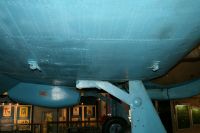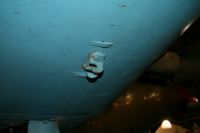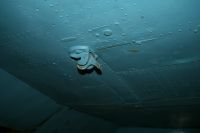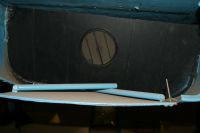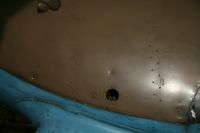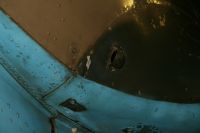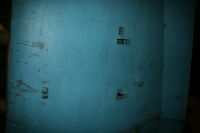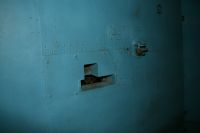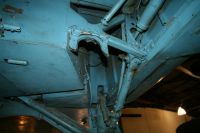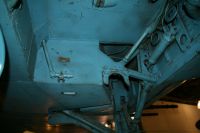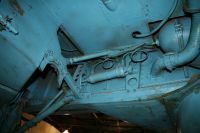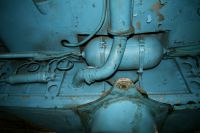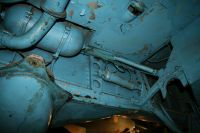Hawker Hurricane IIC
Photos By Max Otten
Photos were taken at the South African Military History Museum, Johannesburg (South Africa) in 2015.
The Hurricane IIC at the museum is a tropicalized version with the Vokes air filter. Its serial number as shown is 5285 but according to http://www.goingairside.com/features/sanmmh.html its original serial number was LD619. It is mounted fairly high up so you get a good view of the bottom parts. The aircraft is painted in pale brown/dark green on top (not a standard desert scheme- that would be pale brown/dark brown) and light blue on the bottom. The spinner is red. The inner circle of the fuselage roundels is orange as is the first bar of the fin flash (South African Air Force colours). The underside has been repainted somewhere in the past (even though the paint is starting to peel). The blue paint cannot be original because the wheel bay has been painted to such an extent that it would not be operational any more (among other, the hydraulic retraction cylinders are blue while these should be bare metal). As a consequence I wouldn’t trust the paint scheme.
Photos 1 through 3 (above) show some larger overviews of the aircraft. Photos 4 through 6 (above) show the drop-tank shackles underneath the starboard wing, photo 4 both of them, 5 and 6 more detailed of the front and back shackles.
Photo 7 (above) shows the air intake of the Vokes filter. It looks like the intake is closed (so the air passes through the filter). Photos 8 and 9 (above) show the radiator from front and back. The blue bars lying on the radiator flap at the back should be roughly vertical and were used to lower the flap.
Photo 10 (above) shows the port side of the nose. It looks like the hole was used for manually starting the engine (with cranks, see below). There is a similar hole on the other side. The inlet/outlet at the far top, left of center are for the generator cooling. Photo 11 (above) is also of the port side and shows another intake, purpose unknown (to me).
Photos 12 through 14 (above) show the cannon spent cartridge ejector chutes underneath the port wing. The chute that consists of two separate holes is the outboard one. When I look at the photo of the starboard wing, the chutes do not seem to be present (if really so, that is not original).
The remaining photos show the main undercarriage bay. As I said, the colouring isn’t original but otherwise it looks to be in good shape. Photos 15 through 20 (above) make the round from the port side to the starboard side, going round the front. Photo 21 shows the bottom almost straight up. Photo 17 shows a removable crooked bar on the side wall (the other side has one as well). I remember it being mentioned somewhere that the cranks used for manually starting the engine (through the holes in the engine cover – photo 10) were stowed in the undercarriage bay so I guess that is what we are seeing. The tank (photos 18-20) is the oxygen tank. The big pipe that goes over it, from the front to the back of the bay is a coolant pipe. The thin line that runs roughly parallel to coolant pipe is the brake line. It connects to the structure seen at the bottom of photo 21 (above) (as well as above the radiator in photo 8). The small, darker rectangles in the center of the two halves of the bottom are clear-view panels through which the pilot could see whether the wheels were retracted. From what comes out underneath the peeling paint it looks like the undercarriage bay was originally covered in silver paint.
© Max Otten 2015
This article created on Sunday, April 19 2015; Last modified on Tuesday, April 12 2016

